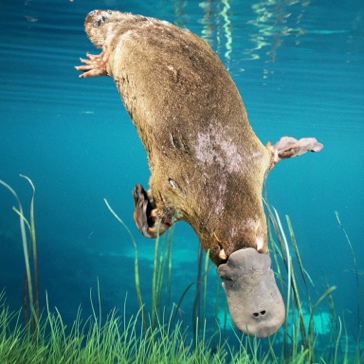
General Information
One of the most amazing transitional forms between reptiles, birds, and mammals is the platypus, a modern mammal. The platypus was first discovered in 1797 on the shores of Australia, and it took many years for researchers to figure out what the chimera was. Today platypus is fully aquatic mammals, as indicated by their elongated bodies, rubbery limbs, and huge tails, which act partly as back fins. It is noteworthy that platypuses are rare representatives of poisonous mammals since, by puberty, males develop hooks on their hind limbs impregnated with the poisonous secretion of their femoral glands.
The range of today’s platypus is represented mainly by coastal areas of freshwater reservoirs, and the animal leads a secretive lifestyle. The platypus dives excellent to hunt for food, which includes algae, crustaceans, mollusks, and small fish. However, these mammals live above water, where they build small burrows of twigs, earth, and water-floating plants. Interestingly, the platypus is an egg-laying animal, so in order to reproduce, the mammal must build nests and incubate its eggs.
Skull structure
The platypus skull has a distinctive feature: the bones of its various zones are so fused that it is sometimes difficult to distinguish the natural boundaries between them. In addition, the animal has a beak, which is formed from the outgrowth of two nasal and jawbones. Until it reaches the age of a mature animal, the platypus’s jaw contains loose teeth, but they wear off as they are used. New teeth do not grow, and instead, platypuses use keratinous outgrowths of epithelial tissue to chew food. The nasal passages of the skull are long, and the cheekbones are thicker and more powerful. When submerged, the skull inlets are naturally covered and compressed, preventing fluids from entering. The recesses under the eyeballs are deep and positioned so that the animal can see objects in front of it. However, the eyes are useless for diving underwater because the mammal covers them in a turbid environment.
Structure of the postcranial skeleton
The platypus torso is no longer than 45 or 50 centimeters long but can be up to 70 cm long with the tail, weighing up to 2 kilograms. At the back of the skull, there is a connection to the spine, which has a curved appearance. A large part of the spinal column is occupied by the thoracic region, in which the ribs are attached to the vertebrae on both sides. On the ventral side of the body, the ribs flatten into a rigid sternum that protects internal organs from excessive pressure underwater. Duckbills have two pairs of limbs, each ending in four developed fingers and one underdeveloped one pointing sideways.
Each of the limbs consists of two sections: the anterior ones are represented by the humerus and forearm bones, while the posterior ones consist of the femur and shinbones. It is on the hind limbs that males retain the venomous outgrowth. Interestingly, all the limbs of platypuses are short, so the animal cannot move straight on land, but instead, it sort of rolls over from one side to the other. The body naturally ends with a long bony tail, in which fat is stored during life.